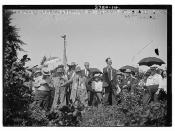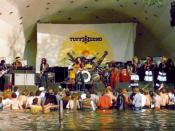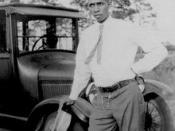It is pretty evident that when a story or information is presented, the view from which the story is told may in deed be the ultimate factor by which the story is judged. This concept also reigns true for documentary type films and plays. and "Freedom Never Dies,"ÃÂ three very different type documentary films, present their stories in two very unique and different ways.
In "Freedom Never Dies"ÃÂ the point of view of the film seems to come from that of the author, Ben Greene. Although the documentary is extremely factual in nature, there seems to be a tendancy of Greene's to suggest that Harry T. Moore was indeed the first of the first for what later became the civil rights movement. Now, according to many of the dates given around Moore's activities, one could imply that perhaps Moore was one of the first but, again, this seems to be the sole intent and focus of Greene; to show that Moore was instrumental in shaping the civil rights movement in the State of Florida.
To help thoroughly tell the story, Greene's use of audio and video solidified the piece. The panning of photos (and stills), worked perfect. Narration, using a Moore-like voice, with pictures stills of Moore on the screen, brought the slain civil rights activist to life. Failure to do so in this piece could have potentially weakened the strength of Green's story because the oppertunity for the viewer to connect with the main subject wouldn't have been as likely. The usage of narration with a man's voice, while showing Moore's picture made it seem like the story was being told to the viewer by Moore himself.
In terms of music, Greene's choice of music seemed to compliment the story line real well. There was, of course , a song or two that was off a little with the storyline but overall, the music worked good too. Specifically so, the use of what sounded like a bass guitar authenticated the film by giving it the sound of the era in which Moore lived. The bass line from the guitar was smooth; almost jazzy sounding.
The stills, graphics, and sot's all seemed to go hand in hand making the story line of this film even more effective. For example, when there was talk in the film of a frozen custard stand being blown up in Central Florida, there was immediate documentation in the form of a newspaper clipping graphic flashed on the screen to reinterate the validity of the fact. Also, throughout most of the film, any time there was a narration done through the "voice"ÃÂ of Moore, a picture or two of the slain leader was shown thus reinterating his existence.
Also, take for instance the brief footage of the white woman dipping her feet into the pool as the narrator broke into the story of Florida and it's racial and weather climate both being hot in 1951. Although the pool image last no longer than about 8 seconds, the transition itself works because it eludes to the idea of hot weather. Simple but effective.
The writing style works for "Freedom Never Dies"ÃÂ because it flows. It doesn't seem like it flows at the beginning but, as you get into the "meat"ÃÂ of the piece, the events from early into the film tie into the events later in the film. For example, at the beginning of the piece, there was talk of Moore and how he lived before he left his small home town and moved to Jacksonville, Fl. Then there was a distinction made between some of the things he had seen different about Jacksonville that he had never seen about his hometown that switched his views on a lot of issues. The switching of some of those views is what actually led to him being who he turned out to be so it was essential to show the turning points in his thought process.
The editing and selection of interviewees also worked very well. Take for example the sot of FBI agent Frank Meech. I thought it was really authentic to have as one of your interviewees, one of the original FBI agents who worked on the case. The editing of the piece, obviously was done well because the editing supports the story line.
Enough about Harry T. Moore, "The Africans"ÃÂ was good but, quite different in style and story structure. Actually the point of view of the documentary kind of went over my head, I guess. Initially I thought it was a documentary about slavery and the links of it's affects on blacks today. this might have actually been the point -of-view but I got sidetracked as the story line went into Muslims and oil.
As for nat sound and video devices, this documentary started on it's feet. At the begining, when the girls were standing around singing, I really thought that added to the piece. There was of course some trickery with the camera angles but, it worked! Even the horse and buggy sound as the narrator steered the horse through the street worked because it added that element of "this is real"ÃÂ to the piece. In addition, the stills of the old man who looked like a slave worked for this piece too because it too added "life"ÃÂ to the theme. I don't know if I would have thought to close in on the still as I talked, like the narrator did in this piece but still, I liked it.
The footage shot inside the Black church really added to the documentary. The narrator talking while the voice of the preacher and the singing of the choir happening all at once was magnificent. The Bob Marley track "lively up yourself"ÃÂ should have worked in this documentary but it simply didn't. First of all, the B-roll to the song didn't match. Secondly, while we all know that Bob Marley is Jamaican, the song nor his nationality really supported the theme of this "african"ÃÂ storyline. I think the narrator could have simply chose an african song and gotten an even stronger affect. While the words to the song were useful, it was the artist and his nationality that said to me, "hey, was this guy just trying to use something black in this to make it work?"ÃÂ The writing style of the narrator was fairly good in terms of how he tried to tell the story. It was quite apparent that there was an awful lot of preparation and information gathering done to successfully tell the story the way he did. I thought it was interesting how he contrasted the reality of slavery by having two African-American women on a ship on there way back to visit an old slavery landmark. To include that in the documentary took writing savvy. Again, I don't think I would have done that myself.
Now, the elements of the story and how they were tied in is where I got lost. The initial theme of the story, or so I thought was Africa; from slavery to now, look where we've come. Okay, wrong!! There were so many different elements tied into this story that I really don't see how the writer expected the viewer to follow the entire story smoothly. Again, I was following until he started talking about Islam and oil. I think those elements of his documentary could have been left out and the documentary could have still been just as strong.
The Shot composition and framing of this documentary also work well except, I didn't understand why out of all the interviewees in the documentary, the only one that he shot really close on, in the face, was the older black woman toward the end of the piece. I don't know if it was because she was elderly, and he wanted to capture her intimate side with the children with whom she was interacting or if it just happened that way. It was peculiar though.
Last but not least for "The Africans,"ÃÂ the VO's, and music worked well too. The narrator's tone was about right for this piece. Whether he came directly on-screen or he chose to talk through a VO, it all seemed to work for him.


![[Portrait of Oscar Moore, Nat King Cole, and Wesley Prince, New York, N.Y., ca. July 1946] (LOC)](https://s.writework.com/uploads/1/15882/portrait-oscar-moore-nat-king-cole-and-wesley-prince-new-yo-thumb.jpg)
![[Portrait of Wesley Prince, Oscar Moore, and Nat King Cole, Zanzibar, New York, N.Y., ca. July 1946] (LOC)](https://s.writework.com/uploads/1/15882/portrait-wesley-prince-oscar-moore-and-nat-king-cole-zanzib-thumb.jpg)

